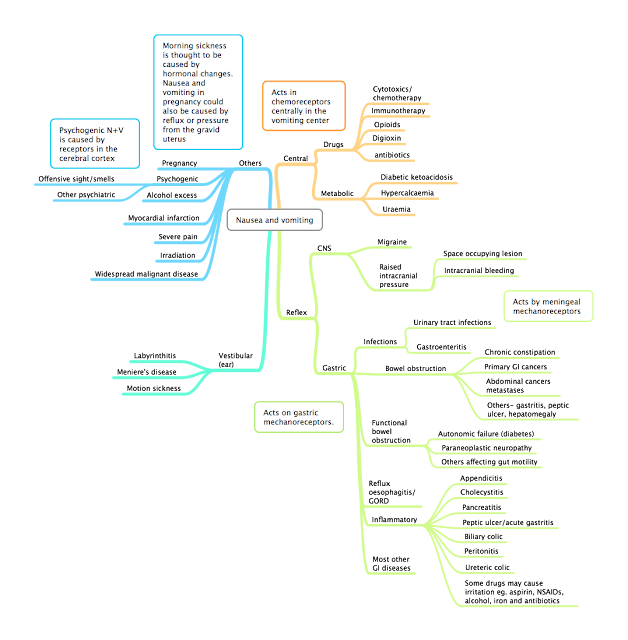Nausea and vomiting and antiemetics
If a patient presents with nausea and vomiting, a clear cause should be established before perscribing antiemetics, as nausea and vomiting may be a sign of serious illness such as diabetic ketoacidosis, and may be reversed by treating the cause, for example in digoxin overdose. The cause of nausea and vomiting may be apparent with history and examination.
patients with persistent nausea and vomiting should also be assessed for their fluid status, and for any electrolyte abnormalities caused by the vomiting.
Causes of nausea and vomiting
Nausea and vomiting may be caused centrally through stimulation of the vomiting center and the chemoreceptor trigger zone in the medulla, or caused afferent signals due to irritation in other areas of the body, usually in the gastrointestinal tract, but also due to disease in the central nervous system or the vestibular system in the ear.
There are several types of antiemetics, some of which act more centrally and some which act more peripherally.
Group
|
Action
|
Suitable
for
|
Antihistamines
Cyclizine
Cinnarizine
Meclizine
Promethazine
|
Antagonises
H1 receptors
|
More
effective against nausea and vomiting due to vestibular causes or peripheral
causes such as irritants in the Gastrointestinal tract.
Promethazine is first line in severe morning sickness. |
Muscarinic
antagonists
hyoscine
|
Antagonises
muscarinic receptors
|
Mostly
used for motion sickness
|
Serotonin
(5-HT3) antagonists
Odansetron
|
Acts both
peripherally and centrally
|
Useful in
postoperative nausea and vomiting and nausea and vomiting due to
chemotherapy.
|
Dopamine
antagonists
Metoclopamide
Domperidone
|
Acts centrally
but also has an effect on the gastrointestinal tract.
|
Metoclopamide
may be used for nausea and vomiting associated with the GI system but has
many side effects. Domperidone also
acts on the chemoreceptor trigger zone, but does not cross the blood brain
barrier as easily and has less side effects. It may be used to treat GI
symptoms as well as nausea and vomiting due to cytotoxic therapy.
|
Antipsychotics
Chlorpromazine
Perphenazine
Prochlorperazine
Trifluoperazine
Haloperidol
|
Dopamine
antagonists, acts on the chemoreceptor trigger zone.
|
Used in
diffuse metastatic disease, radiation sickness, and nausea and vomiting
caused by drugs. Haloperidol and levomepromazine is used in palliative care.
|
Steroids
Dexamethasone
|
Mode of
action not known
|
Often
used synergistically with dopamine antagonists or 5-HT3 antagonists, but has
some antiemetic effects by itself.
|
There are different guidelines for which antiemetics to use for specific scenarios.
http://www.patient.co.uk/doctor/persistent-nausea-or-vomiting
http://www.medscape.org/viewarticle/559665
BNF september 2012
Rang and Dale pharmacology
Churchill's pocketbooks differential diagnosis.


Comments
Post a Comment